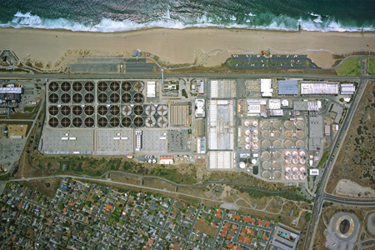Advancing Water Reuse In The U.S.: States Develop Potable Reuse Regulations
By Rob McCandless

Water reuse is happening around the world, from Australia to the UK to Singapore. And it’s gaining more traction in the U.S., especially in states that face drought, population growth, or are more susceptible to climate change.
In several states, government agencies and utilities are exploring how to treat wastewater properly so it can be used for drinking water — what we know as potable water reuse. While potable reuse is not a new concept, it’s being pursued more aggressively with renewed support and new ideas as we see limits with existing water sources.
What Is Potable Reuse? Why Do We Need It?
Using treated wastewater as a new source to treat for drinking water is known as potable reuse. There are two types: indirect potable reuse (IPR) and direct potable reuse (DPR).
IPR involves placing recycled water back into an environmental source, like a reservoir or a groundwater aquifer, before it is introduced to the distribution system. Water for IPR is recoverable for any use, but because it’s indirect, it is not immediately available to consumers. In many places, treated wastewater that is discharged into a river becomes part of the supply to a drinking water treatment plant. This mode of reuse is known as “de facto” reuse.
In other places, treated wastewater undergoes further treatment before being introduced to the environmental buffer. Using an environmental buffer also provides long-term storage to balance seasonal differences in drinking water demand and wastewater supply.
With DPR, there is no environmental buffer — the highly treated water can be blended with other sources at a water treatment plant or introduced directly into the distribution system. As one would expect, there are additional treatment steps and safeguards for DPR systems. Water treated for DPR is safe for any use, any time of the year.
For states or municipalities that haven’t developed or adopted guidelines around potable reuse, IPR is a good first step. As the name implies, the environmental buffer provides a spot to offset and absorb some variation in water quality. This can help change public perceptions about the origin of the water.
On the other hand, IPR may require extensive conveyance, which adds costs to a program. Some water can also be lost through evaporation, seepage, or groundwater migration.
In a handful of states, DPR is gaining significant traction. This process moves treated wastewater more quickly so it can meet the local demands faster and with less water lost along the way. But DPR faces public perception challenges because people may wonder if the purified water that goes directly back into the drinking water supply is truly clean. The fact is, all water is recycled. To purify it, we use science, engineering, and technology to accelerate the natural processes that clean water in our environment.
Certain communities are more willing to adopt DPR. This is typically because they understand it is going to help meet local water demands given their local sources and supply.
An Overview Of Different States And Status For Regulations
So where are we today with adoption of indirect or direct potable reuse in the U.S.?
While many states may recognize the need for water reuse, only a few have taken steps to implement it on a large scale. Drought or climate change have heavily impacted which states explore DPR regulations. These states are thinking ahead, taking steps now to replenish and reimagine their water supply.
DPR regulations are a hot topic in the western U.S. Colorado was the first state in the U.S. to set DPR regulations, with the state’s Department of Public Health and Environment adopting updated standards at the beginning of 2023.
In December of 2023, California’s State Water Resource Control Board voted to pass new DPR regulations to set some of the most comprehensive standards in the country for converting wastewater into high-quality drinking water. California is already leading the way in water reuse with projects my team has worked on like Pure Water San Diego, a multi-year program that aims to provide nearly half of San Diego’s water supply by 2035. There’s also the Los Angeles Hyperion 2035 program that we began working on in 2016 — an ambitious program to move Los Angeles toward 100% recycled water. With new regulations now guiding DPR, we expect even more innovation throughout the state.
Arizona is following suit. The Arizona Department of Environmental Quality (ADEQ) recently proposed plans to set up similar guidelines for the state, which could be adopted as soon as this year. A colleague and I have been involved with the advocacy to open rulemaking for DPR and help define these regulations for ADEQ. Stantec recently won a contract with ADEQ to support development of guidance documents for DPR.
In the southern U.S., Texas has also been innovative on this front. The state has permitted some water treatment plants for direct and indirect potable reuse. The state provides guidance but evaluates water reuse and treatment on a case-by-case basis.
With more DPR regulations in place, communities within these states will know what steps to take and how to treat their water for reuse purposes.
Taking Water Reuse Further
While empowering water reuse and recycled water at the state level is a major step forward, there is still more to do. Most existing programs are for large agencies with lots of access to funding and skilled personnel. Smaller communities and towns across the U.S. are showing interest in water reuse as well — but they have far fewer resources to develop, operate, and maintain these systems.
We’ve heard from these smaller communities that they want to build potable reuse programs. For example, Stantec is currently helping the city of Las Vegas, New Mexico, a community of less than 15,000, with an IPR solution.
Another major challenge is brine management at inland reuse facilities, which have limited brine disposal options. Brine is a byproduct of advanced water treatment processes used for DPR, and my team is working on solutions to these challenges with projects like our Pure Water Antelope Valley program.
To truly reap the benefits of water reuse, we need to figure out how to address the practical needs of program development and operation for towns and cities of all sizes and locations. As we continue to work with these clients, we envision more robust, reliable advanced water purification systems to make them easier to operate and maintain.
 Rob McCandless, North American Water Reuse Treatment Lead at Stantec, has an eye for both technical details and the big picture. Spending most of his career in project management and process design of treatment projects, particularly with membrane technologies, he has over 35 years of experience in the water business as a project manager, process engineer, and civil and mechanical design engineer. His experience includes municipal and industrial sectors with drinking water, wastewater, and water reuse treatment process design — with expertise in membrane technologies including membrane bioreactors (MBR), membrane filtration, nanofiltration, and reverse osmosis.
Rob McCandless, North American Water Reuse Treatment Lead at Stantec, has an eye for both technical details and the big picture. Spending most of his career in project management and process design of treatment projects, particularly with membrane technologies, he has over 35 years of experience in the water business as a project manager, process engineer, and civil and mechanical design engineer. His experience includes municipal and industrial sectors with drinking water, wastewater, and water reuse treatment process design — with expertise in membrane technologies including membrane bioreactors (MBR), membrane filtration, nanofiltration, and reverse osmosis.
